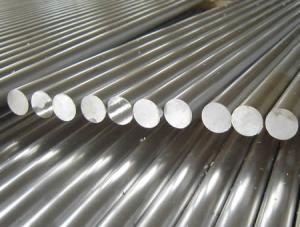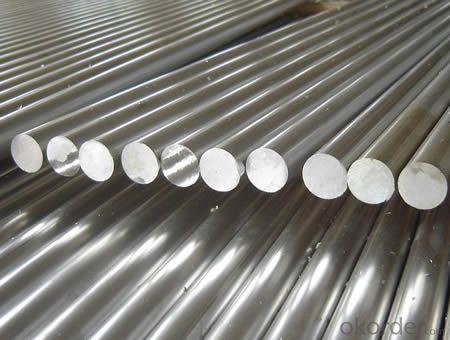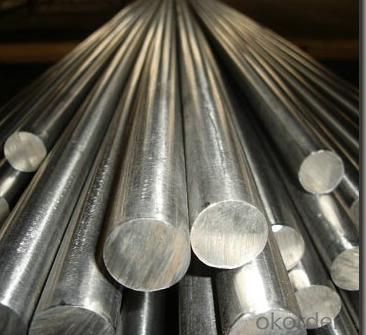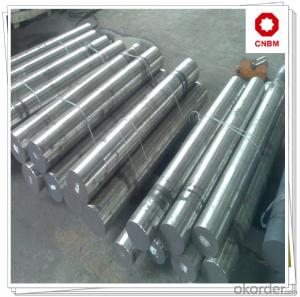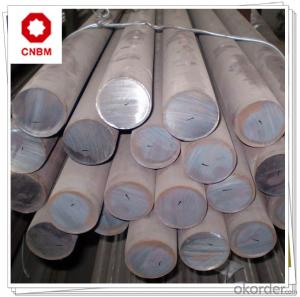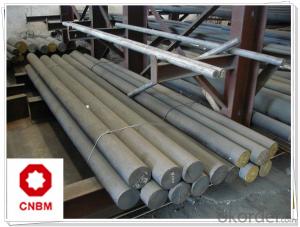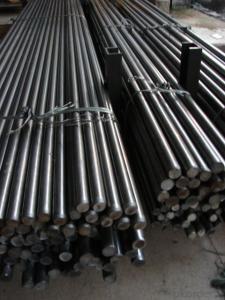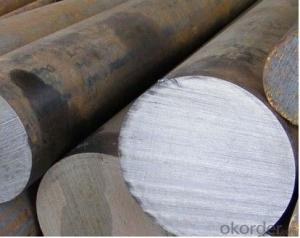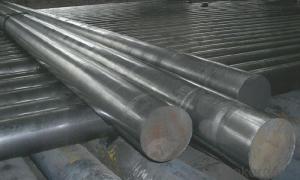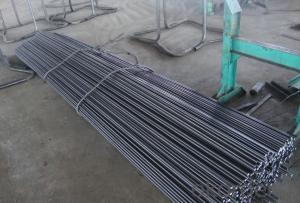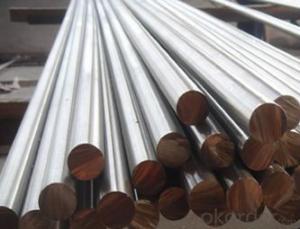Cold Drawn Steel Round Bar with High Quality-50mm-75mm
- Loading Port:
- China Main Port
- Payment Terms:
- TT or LC
- Min Order Qty:
- 100 m.t
- Supply Capability:
- 10000 m.t/month
OKorder Service Pledge
OKorder Financial Service
You Might Also Like
Cold Drawn Steel Round Bar with High Quality-50mm-75mm
Product Description:
Specifications:
1.Size: 50mm-75mm
2.Material: AISI 1045/DIN 1.1191/JIS S45C/GB 45/EN8.
3.Chemical analysis:
C | Si | Mn | P≤ | S≤ | Cr |
0.40~0.60 | 0.20~0.30 | 0.70~0.90 | 0.030 | 0.030 | 0.01~0.03 |
4.Process: EAF + LF + VD + Forged + Heat Treatment (optional)
5.Delivery condition:Hot forged +Rough machined (black surface after Q/T)+ Turned (optional)
6.Technical Data: Chemical Composition, Physical Properties and Mechanical Testing.
7. Test: Ultrasonic test according to SEP 1921-84 3C/c.
8. Standard: GB, AISI, ASTM, DIN, JIS, BS, etc.
9. Quality Management Certification: ISO 9001:2008.
10. Main application:
(1)It is widely used in machinery manufacturing.
(2) For the manufacture of high strength requirements parts, such as gears, shafts, piston pin and the uneven force big machining parts, forgings, stampings and bolts, nuts, pipe joint.
FAQ of Cold Drawn Steel Round Bar with High Quality-50mm-75mm:
Q1: Why buy Materials & Equipment from OKorder.com?
A1: All products offered byOKorder.com are carefully selected from China's most reliable manufacturing enterprises. Through its ISO certifications, OKorder.com adheres to the highest standards and a commitment to supply chain safety and customer satisfaction.
Q2: How do we guarantee the quality of our products?
A2: We have established an advanced quality management system which conducts strict quality tests at every step, from raw materials to the final product. At the same time, we provide extensive follow-up service assurances as required.
Q3: How soon can we receive the product after purchase?
A3: Within three days of placing an order, we will arrange production. The shipping date is dependent upon the quatity, how many sizes you want and the plan of production, but is typically 1 month to 2 month days from the beginning of production.
Images of Cold Drawn Steel Round Bar with High Quality-50mm-75mm:
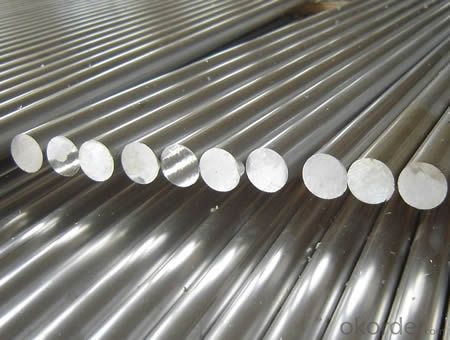
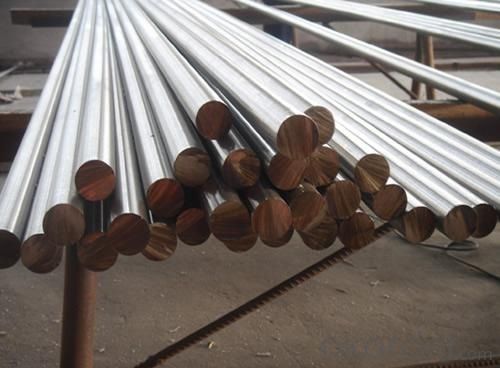
- Q: Can steel round bars be used for making mining equipment?
- Yes, steel round bars can be used for making mining equipment. Steel round bars are commonly used in the manufacturing of various mining equipment due to their high strength, durability, and resistance to wear and tear. They are suitable for applications that require heavy-duty and robust equipment, such as drilling rigs, excavators, crushers, and conveyor systems used in the mining industry. The versatility of steel round bars allows them to be machined, welded, and formed into different shapes and sizes, making them ideal for customizing mining equipment to meet specific requirements. Additionally, steel round bars can withstand harsh operating conditions in mining environments, including exposure to abrasive materials, extreme temperatures, and heavy loads.
- Q: Can steel round bars be used for making transmission towers?
- Certainly, transmission towers can be constructed using steel round bars. The construction industry frequently utilizes steel round bars owing to their robustness, longevity, and adaptability. Transmission towers necessitate materials capable of enduring harsh weather conditions, accommodating hefty loads, and ensuring structural steadiness. Steel round bars effectively fulfill these criteria, rendering them a fitting option for erecting transmission towers. Moreover, steel round bars can be effortlessly fabricated and welded, permitting the swift and efficient construction and installation of transmission towers.
- Q: Can steel round bars be used in the medical industry?
- Yes, steel round bars can be used in the medical industry. They are commonly used in the manufacturing of surgical instruments, orthopedic implants, and other medical devices due to their strength, durability, and resistance to corrosion.
- Q: How do you prevent steel round bars from rusting during transportation?
- There are several effective measures that can be taken to prevent rusting of steel round bars during transportation. Firstly, it is crucial to properly package the steel round bars. This involves securely wrapping and sealing them using moisture-resistant materials like plastic or shrink wrap. This packaging will act as a barrier against moisture and prevent direct contact with air. Secondly, the inclusion of desiccants inside the packaging can help absorb any moisture that may be present. Desiccants such as silica gel packets or moisture-absorbing clay will create a dry environment around the steel bars, reducing the chances of rust formation. Another effective method is to use VCI (Volatile Corrosion Inhibitor) packaging. VCI materials release a protective vapor that forms a thin layer on the steel surface, inhibiting corrosion. VCI films or papers can be utilized to wrap the steel round bars, providing long-lasting rust protection. Proper storage conditions are also crucial during transportation. The steel round bars should be stored in a dry and well-ventilated environment, away from rain, humidity, and extreme temperature fluctuations. If possible, they should be stored in a covered and climate-controlled area to minimize the risk of rust formation. Regular inspection and maintenance of the steel round bars during transportation is essential. This ensures that the packaging remains intact and no moisture has seeped in. If any damage or signs of moisture are detected, immediate action should be taken to rectify the issue and prevent rust from spreading. By implementing these preventive measures, the risk of rust formation on steel round bars during transportation can be significantly reduced, guaranteeing that they arrive at their destination in optimal condition.
- Q: Are steel round bars suitable for use in the manufacturing of valves?
- Yes, steel round bars are suitable for use in the manufacturing of valves. Steel round bars offer excellent strength, durability, and corrosion resistance, making them ideal for various applications including valve production. Additionally, steel round bars can be easily machined and fabricated into different shapes and sizes, allowing for customization according to specific valve requirements.
- Q: How do you measure the straightness tolerance of a steel round bar?
- To measure the straightness tolerance of a steel round bar, you can use a straightness measuring instrument such as a straight edge or a laser alignment tool. By placing the instrument along the length of the bar, any deviations from straightness can be observed and measured. The maximum allowable deviation from a perfectly straight line, known as the straightness tolerance, is typically specified in the industry standards or customer requirements.
- Q: What are the options for joining steel round bars?
- Joining steel round bars can be achieved through various methods, depending on specific requirements and applications. Some commonly used techniques include welding, bolting, adhesives, mechanical couplings, and cold forming. 1. Welding is a widely employed method to join steel round bars. It entails melting the ends of the bars and fusing them together using arc welding, MIG welding, or TIG welding. This technique ensures a robust and durable joint capable of withstanding high loads and stresses. 2. Bolting involves using bolts, nuts, and washers to connect steel round bars. Holes are drilled through the bars, and bolts are inserted, securing them together by tightening the nuts. Bolting is a relatively simple and swift method that allows for disassembly and reassembly, if necessary. 3. Adhesives can also be utilized for joining steel round bars. Industrial-strength adhesives are applied to the mating surfaces of the bars, which are then pressed together and left to cure. This bonding technique can provide a sturdy and durable joint, particularly when welding or bolting may not be feasible or desired. 4. Mechanical couplings, specifically designed for joining steel round bars, are comprised of two separate components fitted over the ends of the bars. These components are tightened together using screws, clamps, or other mechanical means, ensuring a reliable and secure joint without the need for welding or drilling. 5. Cold forming techniques, such as swaging or crimping, can also be employed to join steel round bars in certain cases. These methods involve mechanically deforming the ends of the bars to create a tight and secure joint. Cold forming is often utilized in applications where welding or other traditional methods are unsuitable. When selecting the appropriate method for joining steel round bars, it is crucial to consider specific requirements, load-bearing capacities, and environmental conditions. Consulting with a professional engineer or welder can help determine the best option based on the specific application and desired outcome.
- Q: 4145H round steel is equivalent to the domestic brand?
- 42CrMo steel is ultra high strength steel, high strength and toughness, hardenability is also good, no obvious temper brittleness, after quenching and tempering treatment have high fatigue limit and anti shocksand low temperature impact toughness. The steel is suitable for making large and medium plastic moulds with certain strength and toughness.
- Q: What is the cost of a steel round bar?
- The cost of a steel round bar can vary depending on several factors such as the size, grade, and supplier. Generally, the larger the diameter and length of the round bar, the higher the cost. The grade of steel also plays a significant role in determining the price, as different grades have varying levels of strength and durability. Additionally, the supplier and location can impact the cost due to factors like transportation and market demand. To get an accurate cost estimate, it is best to contact a local supplier or check online metal marketplaces for current prices.
- Q: How are steel round bars used in the construction of high-rise buildings?
- Due to their strength, durability, and versatility, steel round bars are commonly utilized in the construction of high-rise buildings. Carbon steel is typically used to manufacture these bars because it possesses excellent mechanical properties and can endure high loads and pressures. In reinforced concrete structures for high-rise buildings, steel round bars are primarily employed. They serve as reinforcement in concrete beams, columns, and slabs. By embedding the bars in the concrete, the overall structure gains added strength and stiffness. One of the main benefits of utilizing steel round bars is their ability to withstand tension forces. Concrete is strong in compression but weak in tension. Therefore, the steel bars act as tension reinforcement, preventing the concrete from cracking or failing when subjected to tension loads. This significantly improves the building's structural integrity and overall safety. Moreover, steel round bars offer easy bending, shaping, and welding, allowing for flexible design and construction options. They can be customized to specific lengths and diameters to meet the requirements of the building project. This adaptability makes them ideal for constructing various structural elements, like beams and columns, which must be precisely engineered to support the weight and stresses of a high-rise building. Furthermore, steel round bars exhibit excellent resistance to corrosion, which proves crucial when constructing high-rise buildings exposed to various environmental elements. The steel's corrosion-resistant properties ensure the structure's long-term durability and lifespan. In conclusion, steel round bars are essential in the construction of high-rise buildings as they provide strength, durability, and flexibility to reinforced concrete structures. They enhance the overall structural integrity, safety, and longevity of the building, making them a crucial component in modern construction practices.
Send your message to us
Cold Drawn Steel Round Bar with High Quality-50mm-75mm
- Loading Port:
- China Main Port
- Payment Terms:
- TT or LC
- Min Order Qty:
- 100 m.t
- Supply Capability:
- 10000 m.t/month
OKorder Service Pledge
OKorder Financial Service
Similar products
Hot products
Hot Searches
Related keywords
